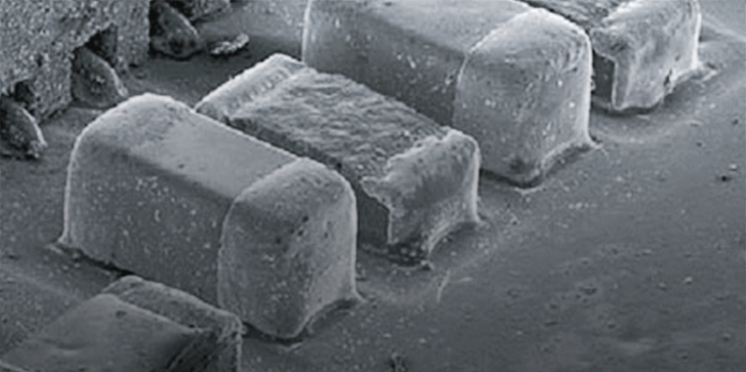diffraction contrast
diffraction contrast
Scattered electrons in a crystalline specimen are not continuously distributed with scattering angles but discontinuously distributed as diffracted waves. Diffraction contrast means the intensity change in an electron microscope image that is formed when the diffraction condition is changed with areas of the specimen. In the bright-field image (formed by the transmitted wave), the area where diffraction takes place loses its image intensity, thus getting dark. In the dark-field image (formed by a diffracted wave), the corresponding area gains image intensity, thus getting bright.

TEM images and a diffraction pattern of polycrystalline Si (a semiconductor interconnect) taken at an accelerating voltage of 200 kV.
(a) Bright-field TEM image. The specimen is composed of many crystalline particles with size of a few 10 nm to a few 100 nm, which exhibit different crystal orientations. In the crystalline particles indicated by red allows and a green arrow, the diffracted waves are intercepted by the objective aperture. As a result, the particles are observed with dark contrast.
(b) Dark-field TEM image taken from the same area in (a). The objective aperture is inserted so that the diffracted wave from the crystalline particles indicated by the green arrow in (a) is acquired. As a result, the particle is observed with bright contrast.
(c) Diffraction pattern. Since the specimen is polycrystalline, the Debye-Scherrer ring is observed. A green circle encloses the diffracted wave from the crystalline particle indicated by the green arrow in (a) and (b).

TEM images and a diffraction pattern of polycrystalline Si (a semiconductor interconnect) taken at an accelerating voltage of 200 kV.
(a) Bright-field TEM image. The specimen is composed of many crystalline particles with size of a few 10 nm to a few 100 nm, which exhibit different crystal orientations. In the crystalline particles indicated by red allows and a green arrow, the diffracted waves are intercepted by the objective aperture. As a result, the particles are observed with dark contrast.
(b) Dark-field TEM image taken from the same area in (a). The objective aperture is inserted so that the diffracted wave from the crystalline particles indicated by the green arrow in (a) is acquired. As a result, the particle is observed with bright contrast.
(c) Diffraction pattern. Since the specimen is polycrystalline, the Debye-Scherrer ring is observed. A green circle encloses the diffracted wave from the crystalline particle indicated by the green arrow in (a) and (b).
Related Term(s)
Term(s) with "diffraction contrast" in the description
Are you a medical professional or personnel engaged in medical care?
No
Please be reminded that these pages are not intended to provide the general public with information about the products.




